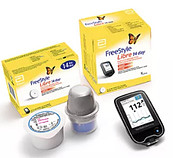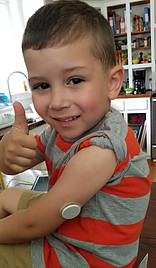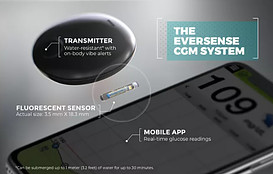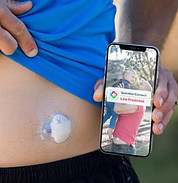I will never forget that day in June 2019 when our then 4-year-old grandson was diagnosed with type 1 diabetes. The endless finger pokes just broke my heart. When his doctor recommended he start wearing a CGM that began our quest to discover what is the best continuous glucose monitors.
So here we are almost two years later and the knowledge we have gained is beyond measure. As the grandparents of a type 1 diabetic, we are not the main caregivers but we still need to have a full working knowledge of how to care for our grandson.
We love having sleepovers and as summer approaches we will want to take the kids on another sailing adventure. This means I need to be on point with caring for Alex’s diabetes.
The continuous glucose monitor he wears makes checking his blood sugars so much easier and the bonus is significantly fewer finger pokes.
Yes, we do still need to do some finger pokes but there sure are a lot less of them.
So what are the best CGMs and why?
Well, let’s take a closer look at some of the most popular options.
Table of Contents
Freestyle Libre Systems
A Freestyle CGM system consists of a sensor and a reader. The small sensor is placed in the back of the upper arm and  measures the glucose levels within the interstitial fluid which is located just under your skin.
measures the glucose levels within the interstitial fluid which is located just under your skin.
To check your blood glucose level, you simply scan the sensor disc with the reader or your smartphone (with an app). This significantly reduces the number of fingersticks you will need to do.
Naturally, there will still be times when you will need to perform a finger stick. These times will include:
- when you see the “check blood glucose” symbol on your reader
- when symptoms do not match system readings
- when you suspect readings may be inaccurate
- when you experience symptoms of either hypoglycemia(low blood sugar) or hyperglycemia (high blood sugar).
Because of the five-minute delay we always do a finger poke every mealtime to ensure accurate insulin dosing.
Our grandson Alex wears the Freestyle Libre and much to my daughter’s excitement the Freestyle Libre 2 System has recently been approved by the FDA in Canada. There are a few key differences between the two systems but first, let’s look at the similarities.
How the two systems are similar
The new FreeStyle Libre 2 has many similarities to the FreeStyle Libre including:
- Fingerpricks are not required for calibration
- It measures your glucose every minute, 1440 readings per day, the highest number of any CGM on the market and five times more reading than competitor brands.

- Sensors are thin and small, the thinnest when compared to competitors. They are about the size of 2 stacked quarters.
- The sensors last up to 14 days.
- A high level of accuracy is maintained throughout the 14 days.
- Sensors are water-resistant so can be worn while swimming, showering, or exercising.
- The reader shows trend arrows to help prevent hypos or spikes
- Built-in glucose testing meter to check your CGM reading
How is the
FreeStyle Libre 2 different?
The FDA classifies the FreeStyle Libre 2 as an iCGM. What does that mean? Simply put, it is a CGM that can integrate with other compatible medical devices, software, and electronic interfaces but it can not control the delivery of insulin through an insulin pump. This system must not be used with an automated insulin dosing system, such as a closed-loop insulin delivery system or insulin suspend system.
The FreeStyle Libre 2 does have a customizable audible alarm that alerts you within a minute of going too low without having to scan. This is the feature my daughter has been so looking forward to. It is also the feature that puts this system on a level playing field with the Dexcom G6. The alarm can be turned on or off so is fully customizable to your preference or circumstance.
This system has a combined mean absolute relative difference (MARD) of 9.3% (9.2% for adults and 9.7% for pediatrics), making it the only iCGM sensor sustaining a high level of accuracy over a 14-day period.
The FreeStyle Libre is designed for adult use and the Freestyle Libre 2 has been approved for use in children 4 years and older as well as adults.
One thing I feel is important to note is that the LibreLink app, which is the app my daughter uses to check Alex’s sugars with her smartphone, is not yet available for FreeStyle Libre 2.
If you prefer using your phone the FreeStyle Libre is the better choice for you at this time.
Dexcom G6
We have found that CGMs are a valuable tool in diabetes management because they provide actionable insight that helps us track Alex’s glycemic response to dietary choices and activity levels with fewer activity interruptions. 
The Dexcom G6 can give you a wireless reading on a dedicated receiver device or to your phone or Apple Watch. This means you don’t actually have to scan the sensor to get a reading.
This would mean our daughter would be able to track Alex’s blood sugar levels while he was at school, which would greatly ease her mind.
The Dexcom G6 reads blood sugars every five minutes, keeping track both day and night.
You can set a range of where you would like your blood sugars to be and whenever you go above or below you will get notified.
For diabetics who wear an insulin pump, the Dexcom G6 can connect with your pump creating a closed-loop system to turn off your insulin if you are going too low.
It is also approved for use during pregnancy offering continuous monitoring visible on your phone at all times.
Our daughter’s insurance company has not approved the Dexcom G6 for Alex unless he were to wear an insulin pump.
Lately, he has been asking for a pump so we may be switching CGMs if he gets approved.
Eversense CGM System
Eversense is really testing the limits of diabetes management. This is the only CGM system that you don’t have to worry about reinserting the sensor for 90 days.
A healthcare provider will insert the sensor and then you place the transmitter above that.
The transmitter itself has the capability of alerting you if your blood sugar is too high or low.
You can also get a phone app and you can receive these readings on your phone.
The blood glucose data from your app can even be shared with your doctor or anyone who wants to check it.
This would be fantastic for parents to keep an eye on their kid’s glucose levels when they are at school or with friends.
Requiring a small incision every 90 days to insert the new sensor was a problem for some patients and the pandemic caused providers to cancel in-person appointments this was no longer such a viable option.
Prior to the pandemic, they had just gained Medicare approval, then the pandemic caused many investors to pull out.
I am uncertain of the future of this 90-day CGM or the newer 365 version currently under development.
Either of these could be a fabulous system once this pandemic is over and in-person visits with healthcare providers is not at risk.
The Guardian Connect System
The Guardian Connect System uses a connected app to tell you your current glucose level. You can also easily access trends and data about your blood sugar over time.
The Guardian offers “predictive” alerts which are different from other CGMs. Other Cgms alert once your blood sugar is either high or low.
The Guardian uses technology that predicts when your blood sugar may go high or low before it happens. Another fantastic feature is the Sugar, IQ diabetes assistant app.
This uses your data to assist you in determining which diet, exercise, and insulin work best for you.
So What’s My Take?
I must say I am pretty impressed with how far medical technology has come when it comes to diabetes management.
We absolutely love the FreeStyle Libre System we are using for Alex.
If our grandson doesn’t get approved for the pump our daughter may opt to upgrade to the FreeStyle Libre 2 System mainly because of the alert function.
This would allow her to sleep better at night because she wouldn’t have to get up so often throughout the night to check his blood sugar levels.
Once Alex gets approved for the pump we will likely switch to the Dexcom G6 because of how it is capable of creating the closed-loop system.
Both the Eversense system and the Guardian Connect System seem like great systems but I don’t think they are for us at this time.
The requirement of a medical professional to insert the sensor makes it not practical while we are still in the midst of pandemic restrictions.
CGMs are expensive so check with your insurer to see how they can help with the costs.
Do you use a CGM?
What features do you like best?
Share your experiences in the comment section below and check here to Save BIG on diabetes supplies.



This must be so valuable information for people needing to choose the best device, Deb, marvelous. As you know I don’t have to deal with Diabetes myself, yet, I am a grandmother as well and I am always interested in your caring and informative articles.
I am wondering what kind of child Alex is, did this sticker on his arm mean any changes in either sporting or playing for him? My grandkids are quite fanatic football playing at the moment, inspired probably by the European Championship 😉 and I have no idea if there would be a difference if any of the kids in the group they play with would have Diabetics?
A child in Alex’s class (my Alex that is) is deaf and all the other kids learn some simple hand signing. It’s awful if a child has an ailment or disease but it’s great if they learn to cope with one another, don’t you think?
Thanks for dropping by Hannie and leaving a comment. I am glad you find my articles useful.
Alex is a pretty active kid and wearing the CGM sensor doesn’t slow him down. We have found that when he is engaging in activities wear he might snag it on something we have taken a sock and cut the top portion off so it will fit over his arm covering the CGM sensor preventing it from getting snagged. We use this when he is busily jumping in and out of the pool. By wearing this band he gets to have fun like any other kid.
We have found that kids are very quick to learn new things from new languages or signs. Our youngest son (27 years old) works with a deaf person and he learned to sign so he could communicate with his co-worker. Apparantly he is more fluent with signing than than the man’s own children.
Yes, kids are very resilient and I see this every time I see Alex. They were here for supper just a couple of days ago and Alex had to proudly show me how he could give himself his own injection. He even dialed the dose on the pen needle. To us that is huge, especially since he is only 6 years old.
Thanks again and take care.